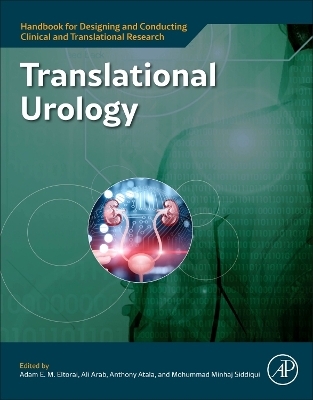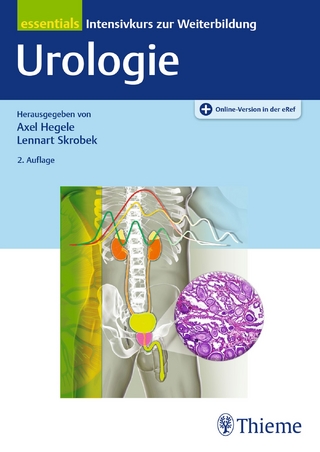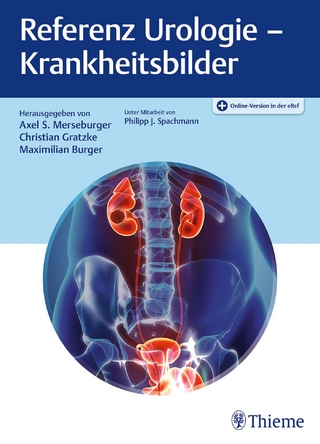
Translational Urology
Academic Press Inc (Verlag)
978-0-323-90186-4 (ISBN)
This practical, straightforward approach helps the aspiring investigator navigate challenging considerations in study design and implementation. The book provides valuable discussions of the critical appraisal of published studies in urology, allowing the reader to learn how to evaluate the quality of such studies with respect to measuring outcomes and to make effective use of all types of evidence in patient care.
Anthony Atala, MD, is the G. Link Professor and Director of the Wake Forest Institute for Regenerative Medicine, and the W. Boyce Professor and Chair of Urology. Dr. Atala is a practicing surgeon and a researcher in the area of regenerative medicine. Fifteen applications of technologies developed in Dr. Atala's laboratory have been used clinically. He is Editor of 25 books and 3 journals. Dr. Atala has published over 800 journal articles and has received over 250 national and international patents. Dr. Atala was elected to the Institute of Medicine of the National Academies of Sciences, to the National Academy of Inventors as a Charter Fellow, and to the American Institute for Medical and Biological Engineering. Dr. Atala has led or served several national professional and government committees, including the National Institutes of Health working group on Cells and Developmental Biology, the National Institutes of Health Bioengineering Consortium, and the National Cancer Institute’s Advisory Board. He is a founding member of the Tissue Engineering Society, Regenerative Medicine Foundation, Regenerative Medicine Manufacturing Innovation Consortium, Regenerative Medicine Development Organization, and Regenerative Medicine Manufacturing Society. Ali Arab is an Associate Professor in the Mathematics and Statistics Department of Georgetown University. He received a BS in Applied Mathematics at the Iran University of Science and Technology (1999) and an MS in Applied Mathematics and Statistics at Southern Illinois University Edwardsville (2002) and PhD in Statistics at University of Missouri-Columbia (2007). He joined Georgetown University in 2007. His academic research is mainly focused on statistical modeling, spatio-temporal models, spatial statistics, hierarchical bayesian modeling with focus on environmental and ecological studies. He frequently publishes in peer-reviewed scientific journals and publishes in academic and popular outlets on topics related to human rights. He is actively involved in promoting science and human rights including promoting the role of human rights in science education, and organizing student activities related to science and human rights. He serves as the Outreach and Communication Committee co-Chair for the American Association for the Advancement of Science (AAAS)-Science and Human Rights Coalition. Dr. Mohummad Siddiqui is a fellowship-trained specialist in Urologic Oncology and Robotic Surgery. He joined the faculty at the University of Maryland in 2014 after completing training at MIT, Harvard, and the NIH in the field of Urology and subspecialty of Urologic Oncology. He is the Director of Urologic Oncology and Robotic Surgery at the University of Maryland Medical Center. He specializes in the surgical management of urologic cancers such as prostate, bladder, kidney, and testicular cancer. Adam E. M. Eltorai, MD, PhD completed his graduate studies in Biomedical Engineering and Biotechnology along with his medical degree from Brown University. His work has spanned the translational spectrum with a focus on medical technology innovation and development. Dr. Eltorai has published numerous articles and books.
INTRODUCTION
1. Introduction
2. Translational Process
3. Scientific Method
4. Basic Research
PRE-CLINCIAL
5. Overview of Preclinical Research
6. What Problem are you Solving?
7. Types of Interventions
8. Drug discovery
9. Drug Testing
10. Device Discovery and Prototyping
11. Device testing
12. Other product types
13. Procedural Technique Development
14. Behavioral Intervention
CLINICAL: FUNDAMENTALS
15. Introduction to clinical research: What is it? Why is it needed?
16. Study population: Who and why them?
17. Outcome measurements: What data is being collected and why?
TATISTICAL PRINCIPLES
18. Common issues in analysis
19. Basic statistical principles
20. Distributions
21. Hypotheses and error types
22. Power
23. Regression
24. Continuous Variable Analyses: Student’s t-test, Rank-Sum Test, and Signed-Rank Test
25. Categorical variable analyses: Chi-square, fisher exact, Mantel hanzel
26. Analysis of variance
27. Correlation
28. Basic science statistics
CLINICAL: STUDY TYPES
29. Design principles: Hierarchy of study types
30. Case series: Design, measures, classic example
31. Case-control study: Design, measures, classic example
32. Cohort study: Design, measures, classic example
33. Cross-section study: Design, measures, classic example
34. Longitudinal Study: Design, measures, classic example
35. Clinical trials: Design, measures, classic example
36. Meta-analysis: Design, measures, classic example
37. Cost-Effectiveness Analysis: Design, Measures, and Classic Example
38. Database Research in Urology
39. Surveys and questionnaires: Design, measures, classic example
40. Qualitative methods and mixed methods
CLINICAL TRIALS
41. Randomized Controlled Trials: Design, Measures, and Classic Examples
42. Nonrandomized control: Design, measures, classic example
43. Historical control: Design, measures, classic example
44. Cross-over: Design, measures, classic example
45. Withdrawal Studies
46. Equivalence and noninferiority: Design, measures, classic example
47. Randomization: Fixed or adaptive procedures
48. Blinding: Who and how?
49. Multicenter considerations
50. Phases of Clinical Trials
51. Window of Opportunity, Phase 0 Trials
52. IDEAL Framework
53. Artificial Intelligence
54. Patient Perspectives
CLINICAL: PREPARATION
55. Sample Size
56. Budgeting
57. Ethics and review boards
58. Regulatory considerations for new drugs and devices
59. Funding approaches
60. Data management
61. Statistical Software
62. Subject adherence
63. Survival analysis
64. Monitoring committee in clinical trials
REGULATORY BASICS
65. FDA overview
66. IND
67. New drug application
68. Devices
69. Biologics
70. Combination Products
71. Foods
72. CMC and GxP
73. Post-Market Drug Safety Monitoring
74. Post-Market Device Safety Monitoring
CLINICAL IMPLEMENTATION
75. Implementation Research
76. Design and Analysis
77. Population- and Setting-Specific Implementation
PUBLIC HEALTH
78. Public Health
79. Epidemiology
80. Public Health Factors and Social Determinants of Health in Urological Research
81. Good Questions
82. Population- and Environmental-Specific Considerations
83. Healthcare Institutions and Systems
84. Public Health Institutions and Systems
Practical Resources
85. Presenting Data
86. Manuscript Preparation
87. Building a Team
88. Patent Basics
89. Venture Pathways
90. SBIR/STTR
91. Sample Forms and Templates
| Erscheinungsdatum | 05.10.2024 |
|---|---|
| Reihe/Serie | Handbook for Designing and Conducting Clinical and Translational Research |
| Verlagsort | Oxford |
| Sprache | englisch |
| Maße | 216 x 276 mm |
| Gewicht | 450 g |
| Themenwelt | Medizin / Pharmazie ► Medizinische Fachgebiete ► Urologie |
| Naturwissenschaften ► Biologie | |
| ISBN-10 | 0-323-90186-7 / 0323901867 |
| ISBN-13 | 978-0-323-90186-4 / 9780323901864 |
| Zustand | Neuware |
| Haben Sie eine Frage zum Produkt? |
aus dem Bereich


